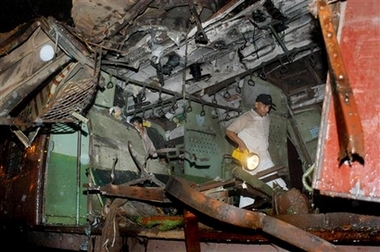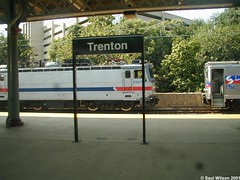Transit without borders or five omissions "in" the Transportation Element of the DC "Comprehensive" Plan
The reason I write about regionalism more and more is because yes, the center city and the suburbs are interdependent, especially with regard to transit.
The LA Times has an op-ed piece about high-speed rail, suggesting strongly that LA and SF be linked in such a manner, reducing car traffic, etc. The piece is titled "L.A.-S.F. train is a quick traffic fix: High-speed rail can crack the two cities' desperate congestion cycle."
One of the sentences in the op-ed resonates with something I've been meaning to write about the Transportation Element of DC's Comprehensive Plan (which I've been too depressed to write and compile my comments about--it's a lot of work, and the "payoff" is questionable). Here's the quote:
To do all this, the mayors will have to look beyond their city limits to understand the role that intercity high-speed rail can play.
I feel the same way about the DC region.
We have to look beyond the city limits. While I always mention three elements of DC's "competitive advantage" there are five:
1. Historic Architecture;
2. An Urban Design that is pedestrian-centric;
3. An authentic history and base of business;
4. A plethora of connected and efficient transportation assets that allow people to not be car-dependent;
5. The stable employment engine of the federal government (still strong despite all the cherry picking by the suburbs and West Virginia).
DC's competitive advantages are dependent on efficient transportation assets that go beyond the automobile. The Transportation Element of the Comprehensive Plan needs to emphasize this.
The Plan does in part, in that this element is listed second, after land use (although I would reorder the elements to put Urban Design first or second), but the section reads as a loose collection of points, rather than a coherent plan.
There are at least five major omissions in the Transportation Element, three have to do with regional issues, and two are city-specific.
1. Regardless of the cost, the idea of adding capacity to the subway system, along the lines of the long since dropped separate blue line proposal from 2001-2002 (and earlier), needs to be put back on the table.
The subway system is getting great usage. It needs more cars and a better intra-car seating configuration to get more throughput. But at some point, only so many trains can get through the system, based on the current configuration. One issue is the subway tunnel at Rosslyn. But another is that there are only two tracks. For redundancy and throughput purposes, this must be addressed.
Dan Tangherlini brought up streetcars as a way to improve intra-city transit, in response to the WMATA plan, because he said that it won't be possible to raise the money to create this separate line (which had two proposed H Street NE stations by the way). But it needs to be reconsidered. See:
-- "Coming to a Curve: Region's Subway System Begins to Show Its Age, Limits" By Lyndsey Layton, Washington Post, March 25, 2001; Page A01
-- "Crowds Could Derail Decades of Progress," By Lyndsey Layton, Washington Post, March 26, 2001; Page A01. From this article:
Many of Metro's capacity problems can be traced to its design. It was built as a two-track railroad, with five lines stretching from the city core to the suburbs in a hub-and-spoke arrangement.
The two-track design means big trouble when a train breaks down. The train has to be hauled down the track until it reaches one of just a few sidings where it can be pulled off the main track. That slows movement on the entire line and explains why a breakdown at Farragut North can affect passengers waiting for trains at Union Station.
"We're like a two-lane country road with no breakdown lane," White said. The two-track railroad also prevents Metro from running express trains. And 24-hour service is out of the question, because Metro needs to shut down its system several hours a day to perform track maintenance. Larger systems suchas New York's, which has up to six tracks at some stations, can perform maintenance on two tracks while running service on others, and can operate round-the-clock.
The other crucial flaw is the fact that four of Metro's lines share track for significant stretches. The Orange and Blue lines, for instance, merge at Rosslyn, then share track through a tunnel under the Potomac River and across downtown Washington until they separate at the Stadium-Armory Station.
Forcing the lines to share track cuts the capacity of each by half and is the main reason inbound Orange Line trains at, say, West Falls Church are standing room only during rush hour. Because a certain distance must be maintained between trains, there's a limit to the number of trains that can be sent down the Orange and Blue track each hour. Plans to extend rail service to Dulles and Tysons Corner may help ease crowding on the roads in an area that lacks rail service. But lengthening the Orange Line to Dulles will exacerbate crowding, by reducing the capacity of the Orange and Blue lines even further.
-- "Metro Construction Projects Creak to Halt; Economic, Political Changes Cancel Expansion Plans, Spur Job Cuts, Early Retirements," Lyndsey Layton. Washington Post, July 13, 2003. pg. C.01. From the article:
Metro headquarters pulsed with big plans. P. Takis Salpeas, the head of construction, was swimming in fresh designs: rail to Tysons and Dulles, a Purple Line that would circle the city, a rail line over the new Woodrow Wilson Bridge, a new subway line through downtown that would finally bring Metro to Georgetown and release the railroad's choke points.
That was two years ago. Today, those plans have largely evaporated, victims of a soured economy and fractured local politics. Metro is not building the next generation of transit -- it is barely able to run its existing system. As construction money dwindles from the current fiscal year through fiscal 2009, Metro's stable of well-regarded architects, engineers and construction managers will be cut from 237 to 23.
__________
Speaking of terrorism, if only for redundancy purposes, adding capacity and separate tracks should be addressed. After all, it's supposed to be a "Comprehensive" Plan.
 A rescue worker surveys the interior of a destroyed train coach after a bomb blast at the Matunga railway station in Bombay, India, Tuesday, July 11, 2006. Eight explosions ripped through packed commuter trains during rush hour Tuesday in India's commercial capital, killing nearly 150 people and injuring another 439 in what officials said was a well-coordinated bomb attack by terrorists. (AP Photo). From "Bomb attack on Bombay trains kills 190."
A rescue worker surveys the interior of a destroyed train coach after a bomb blast at the Matunga railway station in Bombay, India, Tuesday, July 11, 2006. Eight explosions ripped through packed commuter trains during rush hour Tuesday in India's commercial capital, killing nearly 150 people and injuring another 439 in what officials said was a well-coordinated bomb attack by terrorists. (AP Photo). From "Bomb attack on Bombay trains kills 190."2. In the context of the "regional" transportation 'system," DC might have to step up and take the leadership role with regard to proselytizing about the vision and repositioning of "commuter railroad" services. Virginia and Maryland have separate systems. But maybe they ought to be combined.
For a long time, MARC has wanted to be able to cross into Virginia, and deposit riders in Crystal City and Alexandria, without having to put them onto the WMATA subway system (note that this could help add capacity to the WMATA system...). I don't know why this idea hasn't gone anywhere.
Maybe we need to develop a "regional railroad system" rather than have two different state-based "commuter railroads." Virginia and Maryland fund one state-supported vetinerary school open to residents of both states. Maybe it's time for thinking about combining VRE and MARC into one system.
 SEPTA in Trenton, New Jersey. Photo by Saul Wilson.
SEPTA in Trenton, New Jersey. Photo by Saul Wilson.SEPTA, MTA in the NY-CT region, and NJ Transit provide services that cross state lines in significant ways.
 Fantasy map of a Washington-Baltimore regional rail system. By Dan Malouff. This proposal extends service as far south as Richmond, north to Harrisburg, Pennsylvania, and west into West Virginia.
Fantasy map of a Washington-Baltimore regional rail system. By Dan Malouff. This proposal extends service as far south as Richmond, north to Harrisburg, Pennsylvania, and west into West Virginia.3. The Streetcar Studies being pursued by DC and Arlington County represents a technology that Montgomery, Prince George's, and Fairfax Counties need to be considering as well. For example, I have suggested a ninth streetcar line be considered going up Rhode Island Avenue--it could go as far as Laurel. And the proposed Cross Town line, terminating in Brookland, could be extended up Michigan Avenue, Queens Chapel Road, and Adelphi Road to the University of Maryland campus and back, becoming comparable to the Collegetown Network bus service in Baltimore (see "No car, no problem"), as it could link Georgetown, AU, Howard, Catholic University, Trinity College, one of the campuses of Prince George's Community College, and the University of Maryland.
It might be that Fairfax County isn't relevant to DC, but the two Maryland counties are, because they physically connect to DC, and better transit linkages will reduce the automobile traffic that these counties (and Anne Arundel) impose on the City of Washington.
As far as the two intra-city issues that are inadequately addressed by the Transportation Element, here goes:
4. The 8 proposed streetcar lines outlined in the DC Streetcar Studies seem to have been slimmed down to 4. What gives? See page 18 of the Transportation Element and compare it to this map.

5. Why doesn't the Transportation Element require transportation demand management as a matter of course, for all uses other than that of single-family housing, instead of only suggesting it be required for planned unit developments?
This makes no sense. Institutions including schools and churches should be required to develop plans that reduce car trips in a substantive way.
Support for bicyclists and pedestrians should be required.
Parking subsidies should be, for the most part, forbidden, or at the very least matched by comparable subsidies to transit riders.
Multiunit developments should be discouraged from promoting car usage, especially when located to convenient transit.
Incentives should be provided for car sharing.
Instead of just focusing on creating "truck routes" through the city, figure out how to time-shift as many commercial deliveries as possible to evening hours because for the most part, roads downtown, and in the northeast and southeast quadrants are underutilized. (This would have to be balanced with the desire to not negatively impact neighborhoods.)
Certain businesses, such as the Au Bon Pain restaurant chain and the Yes! Grocery Stores get the bulk of their deliveries at night, significantly reducing the impact deliveries would otherwise impose on a somewhat stressed road network.
This practice needs to be more widespread and should be spearheaded through TDM requirements (not guidelines, not suggestions) in the Transportation Element.
Index Keywords: transit; transportation



0 Comments:
Post a Comment
<< Home